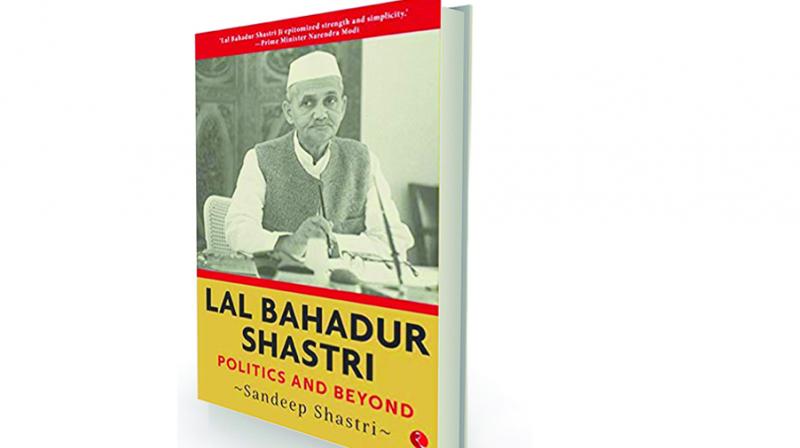Diminutive Gandhian won a war, but was denied his place in the sun

The public memory of Lal Bahadur Shastri, India’s Prime Minister after the death of Jawarhalal Nehru, is almost anecdotal. The stories that stick are about how he resigned as railway minister in 1956 taking moral responsibility for a railway accident; the slogan “Jai Jawan Jai Kisan”; his leadership in the 1965 war with Pakistan; and the mystery that surrounds his death in Tashkent after the war. Not much has been written, at least in popular literature, about the man himself.
Shastri, whose 19-month prime ministership was hemmed between Nehru and Indira Gandhi, has, without doubt, not got the space he deserved in public memory. After the emergence of the BJP and its desperate efforts to appropriate the legacies of “neglected national icons” (mostly Congress leaders), there is a sudden interest, in politics and in other circles, about the lives and contributions of such leaders to the making of modern India, be it Sardar Vallabh Bhai Patel, Subhas Chandra Bose or Lal Bahadur Shastri.
The book — Lal Bahadur Shastri: Politics and Beyond — by Sandeep Shastri is a serious study of the life and legacy of the man best known for restoring India’s pride and self-confidence by winning a war against Pakistan in 1965, three years after a humiliating defeat by China, and also for his initiating the process to make India self-reliant in food production. The narrative fits the muscular nationalism of the current establishment, but on the other hand, his Jai Jawan, Jai Kisan slogan remains relevant, more so in these times of acute farming crisis.
The diminutive Gandhian had stepped into the large shoes of Nehru and successfully faced many challenges putting to rest doubts about his ability to keep the country together. Shastri’s humble background endowed him with a keen practical sense and he was grounded in local reality. He rose from the grassroots and worked at different levels in various capacities before assuming the reins of government. Although mentored by J.B. Kriplani, G.B. Pant and Nehru at different times, he had walked out of their shadows and certainly left his imprint.
Was he Nehru’s natural successor? The book leaves no one in doubt that Shastri was almost groomed by Nehru as his successor. He was the man in charge of the party’s electioneering in the 1952, 1957 and 1962 general elections. He was a permanent feature in Nehru’s cabinet between 1951 and 1964. In 1961, Nehru had entrusted him with the home portfolio after the death of G.B. Pant, virtually ignoring the claims of Morarjibhai Desai (who, after Nehru’s death, was to become a prime ministerial aspirant). That Nehru favoured Shastri as his successor became more evident when he recalled him to his Cabinet as a minister without portfolio a few months after his exit from the government under the Kamaraj Plan. It was but natural that the powerful syndicate headed by K. Kamaraj had to select him, ignoring Morarji’s claims for the prime ministership. Shastri and Nehru had enjoyed a good relationship, with the former backing him strongly during hours of crises. The transition was smooth, thanks also to Shastri’s affable and non-confrontationist approach, which had endeared him to his colleagues both in the party and the government. This is notwithstanding the buzz (which has endured to this day) that Nehru and the syndicate wanted Shastri as a “stop-gap arrangement” to keep the seat warm for Nehru’s daughter, Indira Gandhi. The book refers to Kuldip Nayar’s memoirs, Beyond the Lines and other sources that allude to Shastri’s acknowledgement of the fact that Nehru wanted Indira Gandhi to be his successor, but avoids any comment on whether he at all resented this.
The book dwells on the deft manner in which Shastri handled the anti-Hindi agitation, highlighting his adherence to the principles of democracy. True democrat that he was, he acceded to the demands of the non-Hindi speakers despite, perhaps, his heart being with the votaries of Hindi becoming India’s sole official language. Not relenting under the pressure from the Hindi speaking majority in the party and the government, he went beyond Nehru’s commitment and clearly delineated the Centre’s language policy, which remains the cornerstone of India’s pluralistic democracy (occasional noises notwithstanding).
One chapter is devoted to the leadership displayed during the 1965 war and describes Shastri’s decision to move the Army into Pakistani territory as the “first surgical strike”.
There are anecdotes reflecting Shastri’s personality and values. A telling instance: He rebuked his underage son for managing to procure a driving licence and recommended action against the official who issued the licence. That sums up Shastri as a man who stood for integrity, humility and simplicity, in personal and public life.
The book quotes Shastri’s cabinet colleague T.T. Krishnamachari as saying that Shastri could well have been a “parenthesis in history”. His relatively short tenure as Prime Minister and the Congress Party’s exclusive focus on the Nehru-Gandhi family are the reasons given for why Shastri has been denied his place in the spotlight.

